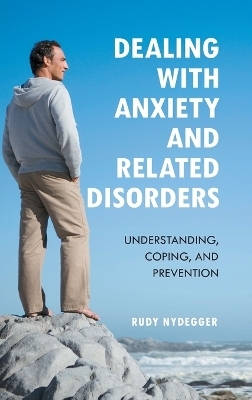
Dealing with Anxiety and Related Disorders
Praeger Publishers Inc (Verlag)
978-0-313-38422-6 (ISBN)
Anxiety disorders are the most common and frequently misdiagnosed and undertreated of all mental health conditions. Dealing with Anxiety and Related Disorders: Understanding, Coping, and Prevention explains in accessible language the myths, misunderstandings, and realities of anxiety disorders, including often misdiagnosed somatoform and dissociative disorders.
Psychologist Rudy Nydegger approaches anxiety and related disorders, including panic disorder, social phobia, obsessive-compulsive disorder, and PTSD, with the most up-to-date and professionally sound information available. The history of and theories about anxiety disorders are thoroughly discussed, as are the most recent ideas and findings. Readers are provided with comprehensive information on each disorder—its description, clinical symptoms, dynamics, and available treatments, including alternative and experimental approaches. Ways in which patients can get help and help themselves are discussed, as are steps family members and friends can take when they know a loved one is struggling with an anxiety disorder. Detailed case studies illustrate both the disorders and the options for treatment.
Rudy Nydegger, PhD, is Professor of Management and Psychology at Union College and Union Graduate College in Schenectady, NY, as well as Chief of Psychology at Ellis Hospital.
Preface
Acknowledgments
1 What Is Anxiety?
The Age of Anxiety
Diagnosing Anxiety Disorders
Diagnostic and Statistical Manual
Multiaxial Diagnoses
Myths about Anxiety
People Who Suffer from Anxiety Disorders
2 Living with Anxiety Disorders
Case 1: Betsy
Case 2: Dan
Case 3: Cheri
3 The Distribution and Effects of Anxiety Disorders: Costs, Gender, Age, and Specific Groups
Gender and Anxiety Disorders
Women and Anxiety
Men and Anxiety
Age and Anxiety
Children and Teens and Anxiety
Diagnosing and Treating Children and Teens
Anxiety Disorders in the Elderly
Treatment of Anxiety in the Elderly
Race, Ethnicity, and Anxiety Disorders
African Americans and Anxiety
Asian Americans and Anxiety
Hispanic Americans and Anxiety
Native Americans and Alaskan Natives and Anxiety
Homosexual Groups and Anxiety
Religious Groups and Anxiety
4 Theories of Anxiety Disorders
Biological Theories
Psychological Theories
Psychodynamic Approaches
Humanistic and Existential Approaches
Behavioral Approaches
Cognitive Approaches
Integrating the Different Theories
Who Is Vulnerable?
5 Physical Responses and Types of Anxiety Disorders I: Generalized Anxiety Disorder and Panic Disorder
Physical Responses to Stress and Anxiety
Responses of the Brain
Responses by the Heart, Lungs, and Circulatory System
Responses by the Immune System
Responses in the Mouth and Throat
Skin Responses
Metabolic Responses
Physical Responses When Stress or Anxiety Disappears or When It Continues
Other Sources of Anxiety-like Symptoms
Types of Anxiety Disorders I
Generalized Anxiety Disorder
Panic Disorder
6 Types of Anxiety Disorders II: Phobias, Posttraumatic Stress Disorder, and Obsessive-Compulsive Disorder
Phobias
Specific Phobias
Social Phobia
Posttraumatic Stress Disorder and Acute Stress Disorder
Obsessive-Compulsive Disorder
7 Treatments for Anxiety Disorders
Medical Treatments for Anxiety Disorders
Antidepressant Medications
Antianxiety (Anxiolytic) Medications
Additional Medications and Natural Substances
Pregnancy and Medications
Other Medical Forms of Treatment
Psychological Treatments of Anxiety Disorders
Other Psychosocial Treatment Approaches
8 Treatment Methods for Specific Anxiety Disorders and Patient Groups
Panic Disorder
Generalized Anxiety Disorder
Social Anxiety Disorder
Specific Phobia
Obsessive-Compulsive Disorder
Posttraumatic Stress Disorder
Other Considerations in Treating Anxiety Disorders
9 Living with Anxiety Disorders
Who Needs Treatment?
Where to Seek Treatment
Types of Mental Health Professionals
Is Treatment Working, and When Is It Completed?
What Patients Can Do to Help Themselves: Stress Management
10 Somatoform Disorders
Malingering and Factitious Disorders
Hypochondriasis
Somatization Disorder
Conversion Disorder
Pain Disorder
Body Dysmorphic Disorder
Other Types of Somatoform Disorders
11 Dissociative Disorders
Background and History
Dissociative Disorders in General
Depersonalization Disorder
Dissociative Amnesia
Dissociative Fugue Disorder
Dissociative Trance Disorder
Dissociative Identity Disorder
Treatments for Dissociative Disorders
12 Making Sense of It All
Changing Conceptions of Anxiety and Related Disorders
Coping with Anxiety and Related Disorders
Being a Positive Voice for Good Mental Health
Making a Difference
Resources
References
Index
| Sprache | englisch |
|---|---|
| Maße | 156 x 235 mm |
| Gewicht | 567 g |
| Themenwelt | Sachbuch/Ratgeber ► Gesundheit / Leben / Psychologie ► Krankheiten / Heilverfahren |
| Sachbuch/Ratgeber ► Gesundheit / Leben / Psychologie ► Psychologie | |
| Geisteswissenschaften ► Psychologie ► Angst / Depression / Zwang | |
| ISBN-10 | 0-313-38422-3 / 0313384223 |
| ISBN-13 | 978-0-313-38422-6 / 9780313384226 |
| Zustand | Neuware |
| Haben Sie eine Frage zum Produkt? |
aus dem Bereich


